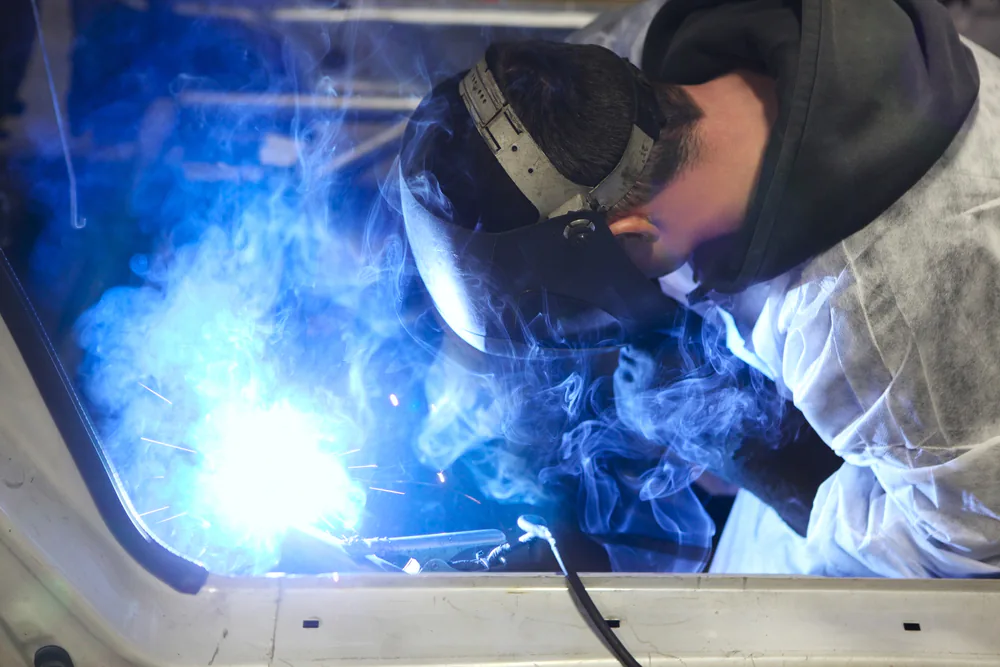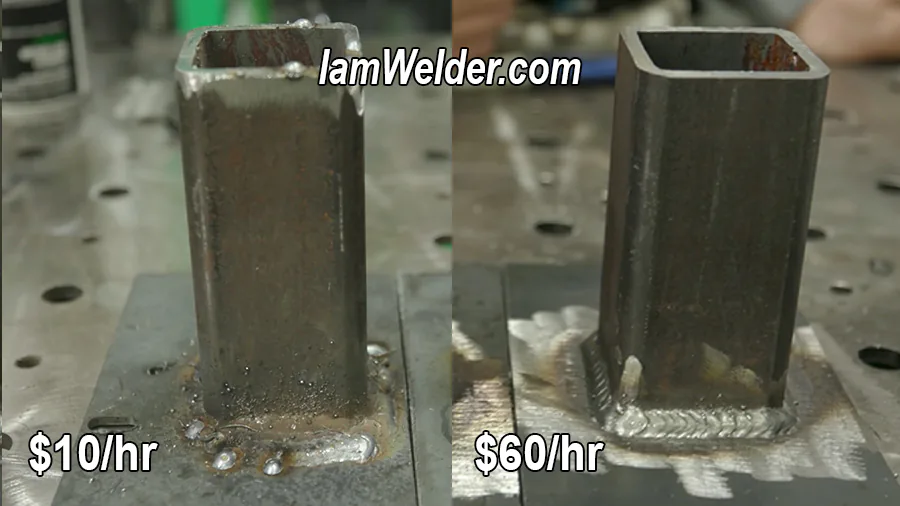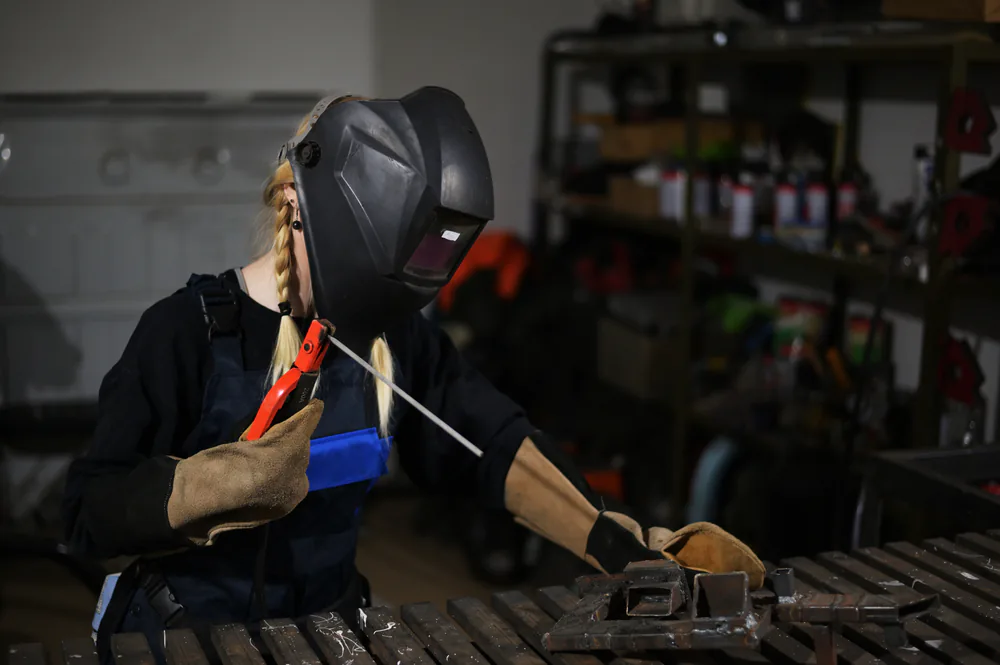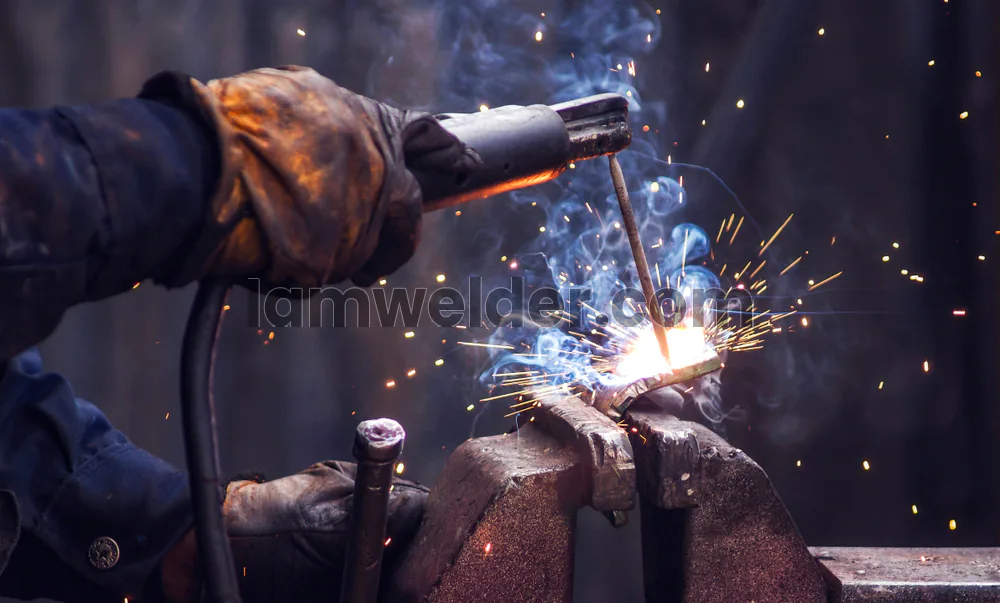Informational
Vehicle Frame Welding: Car, Truck, & Legal Issues Discussed

Frame welding is important for both auto body shops and the truck business as a whole. High-quality welds are important for frame welding because they make a truck safer, more reliable, and look better.
Because of this, every welder needs to know how to weld frames. In this post, we’ll go over everything you need to know to start your own frame welding business.
Frame welding is the welding process used to repair the frames of trucks, automobiles, and other types of vehicles.
All continuously operating vehicles need ongoing maintenance because frames are affected by different forms of pressure. So it’s common that you find yourself in need of welding your vehicle frame.
What Type of Welding Should I Use for My Vehicle’s Frame?
Since the frame is a very important part of a vehicle, the welds should be long-lasting and very strong. Therefore, you need to be very careful when selecting the welding type for your vehicle frame.
Below are a few of the welding methods that work well for frame welding.
- MIG welding
- TIG Welding
- Stick Welding
Related Information: MIG vs. TIG Welding: Which One is Best for You?
Because the quality of a weld depends on so many different things, there is no guarantee that choosing one of the above methods will result in a better frame weld.
The two most important things that affect the quality of a weld are how skilled the welder is and what kind of filler material is used.
For example, a professional TIG welder whose job is to weld aluminum boat railings might not be taught the same ways to do things as a welder whose job is to weld car bodies.
One welding specialist can use a MIG machine to make a high-quality weld, while another won’t be able to produce good welds with the same technique.
Why is TIG welding better for your car’s frame?
Here are a few of the things that make TIG welding a better option for welding your car’s frame:
- More filler material options
- works with a chrome-moly tubing frame.
- Less probability of cold starts
- It works best with heat-sensitive materials.
TIG welding is much better than MIG welding when welding together car frames made of high-alloy steels that are sensitive to heat and could crack in the heat-affected zone.
When compared to MIG welding, TIG welding has a wider range of filler materials, which is a benefit. With MIG welding, the operator doesn’t have as many options as with TIG welding.
What Equipment Do I Need for Frame Welding?
It’s not necessary that you need a special piece of equipment to weld a frame. There are a few things that would make your life much easier if you had them, and getting those things should be your top priority.
- Welding PPE
- Welding Apron
- Welder
- Gas
- Angle
- Grinder
- Vises and clamps
- A Few Jigs (for rare cases)
- Plasma cutter (for rare cases)
- Rotisseries
Fit-Up Jigs:
Because there isn’t much room between the frame rail and the body of the vehicle, welding on the frame while the body is still attached may require the use of special fit-up jigs.
When welding structural tubes or channels inside or on top of the vehicle frame, special fit-up jigs may be helpful.
These clamps, which look like both vice grips and big, adjustable C-clamps, are used to hold the tube or channel in place on the vehicle frame rail before and during welding.
Rotisseries:
Similar to how food rotisseries work, car rotisseries spin a complete vehicle while being fastened to a massive frame from the front and back.
When a vehicle is on a vertical vehicle lift, tasks beneath the vehicle must be carried out. At that time, being able to rotate the vehicle as a whole makes it simpler for the technician working on the vehicle.
Can You Weld a Broken Frame?
Even though it might seem like a good idea to weld the broken frame, you need to know that a weld, even a good one, can become a weak spot that lets more cracks and damage happen.
Therefore It will depend entirely on the kind of frame you want to weld. For example, it is not a good idea to weld the frame of a truck that is used to carry heavy loads. On the other hand, it is safe to weld the frame of a small golf course car.
How Much Does It Cost to Weld a Frame?
So, if you want to know how much it will cost to weld a broken frame, you need to know how bad the damage is and how long it will take to fix it. Then, go to your local welding market and ask how much they are charging for 1 hour of welding.
Generally, welding will cost between $10 and $60 per hour. There are so many different rates because it all depends on how well a welder does his or her job and how much experience he or she has.
Welding costs might also vary based on the job’s complexity. In the event that they weld a frame, they may charge you some extra bucks.

So, you can easily figure out how much it will cost to weld your frame if you know these two things.
Does welding a frame weaken its strength?
Some people will say that welding a frame is a bad idea because it will make the frame weaker. while others will say that welding a vehicle frame is completely safe.
I now think that both sides are right. Because there are times when welding a frame will definitely make it weaker. For example, welding the frame of a heavy-duty truck will definitely make it less strong.
On the other hand, you can weld a frame without worrying about its strength in some situations, for example, welding a gold-course car frame.
Is it Illegal to Weld a Vehicle Frame?
The Federal Motor Carrier Safety Administration’s 49th article (49 CFR 393.201, “Frames”) says that you can’t drill holes in the top or bottom rail flanges. Only if the manufacturer tells you to drill holes in the flanges is this rule broken.
This rule applies to both commercial and light-duty consumer vehicles. This rule applies to both personal vehicles and vehicles used for work.
After a vehicle’s frame rails have been cut, rewelded, drilled, or changed in any other way, it’s likely that it won’t be allowed to be driven on the highway anymore.
If these cars with modified chassis aren’t allowed to drive on highways, they could be marked “off-highway only,” in which case the laws are much less strict.
Even though it’s unlikely that anyone would notice if you used illegally welded frames, doing so could lead to harsh punishments or large fines.
In the event of an accident, the weld on the frame can be traced back to the person who did it, and this person could be held legally responsible for the accident.
Insurance companies won’t cover frames that have been welded, which makes a situation that was already difficult to deal with even more difficult.
Disclaimer: This article discusses legality but does not provide legal advice. If you require legal guidance, contact a lawyer.
Is It Illegal to Sell a Vehicle With a Welded Frame?
It is generally not against the law to sell a vehicle that has a frame that has been welded on (please read the disclaimer above), but it is against the law to sell a vehicle that has a frame that has been welded on or that has been damaged without first informing the buyer of these facts.
It is mandatory to provide a written document that unequivocally says that the vehicle involved has a frame that has been welded.
The signed agreement will be of significant assistance to both the buyer’s and seller’s sides in the event that a legal dispute arises between the parties.
Will Welding Vehicle Frame Damage the Vehicle’s Computer?
You are allowed to weld on your vehicle’s frame and it won’t cause damage to it’s computer however, you must observe some safety measures.
Disclaimer: Before you begin welding on your automobile frame or anywhere else on your vehicle, it is essential that you consult your vehicle’s manual and/or the manufacturer for clear instructions.
Here are a few things that you can do to reduce the risk of your vehicle’s computer being damaged:
- Position the welding ground clamp as close as possible to the welding arc.
- Disconnect the negative battery terminal from the vehicle.
- Remove the plugs from the airbags.
Tip 1: Position the welding ground clamp as close as possible to the welding arc. This will shorten the electrical path between the arc and the ground, reducing the possibility that high voltage may be sent to the delicate computer components in your vehicle.
Tip 2: Always disconnect the negative battery terminal from the vehicle. This will enable you to disconnect your vehicle’s electrical circuits, reducing the likelihood of overvoltage situations that might damage the vehicle’s onboard computer.
Tip 3: Remove the plugs from the airbags found under the hood of your vehicle. There is a potential that some of the welding power might reach your airbags, triggering their deployment.
Although this last tip is not directly related to the vehicle’s computer, since airbags are not only very costly but also may require a “salvage title” for your vehicle if they are deployed,
Conclusion
I’ve made an effort to provide you with a broad overview of frame welding here. Before you begin welding the frame, you need to be sure that you have a solid comprehension of how this works. If you are just starting out, it is in your best interest to refer to others who have more experience in this field.
Informational
How to Weld If You Have Long Hair? Pro Welder’s Tips

Any welding operation that you perform puts you and anyone else in the area in danger of a number of different things. As a result, it is completely reasonable for you to be concerned about preventing your hair from becoming entangled in any welding equipment and posing a threat to your health. In this article, I will talk about how you can safely weld if you have long hair.
If you want to weld while having long hair, a French braid is the best option for keeping your hair together. This will help you in tying your hair and hold it together behind your neck. The French braid should keep the hair compact and close to your head’s shape, and it also allows you to wear a welding helmet. As a result, you will be able to wear full safety equipment.
When you are dealing with hot weld spatters, having long hair can present a particularly difficult challenge. Therefore, if you are interested in learning more about how you can safely weld with long hair, continue reading the rest of this article, where I will discuss the topic in greater detail and share some helpful hints.
How Your Long Hair Can be an Issue While Welding?
Welding procedures, as I indicated earlier, expose the operator as well as anybody else in the vicinity of the workplace to a wide variety of risks. A project involving welding presents a number of potential dangers and threats; it is important that you be aware of these issues in order to protect not only yourself but also others around you. Especially when dealing with spatters, it is easy for things to go wrong if you have long hair.
Before we look at all of the tips you may weld with long hair, we need to first understand the potential risks you run and everything that might go wrong. Long hair poses a unique set of challenges when it comes to welding. A few are mentioned below:
- Spatters are your hair’s worst enemy.
- UV rays can permanently damage your hair.
- With long hair, grinders can cause serious accidents.
Let’s look at these problems one by one:
1. Take Spatters Seriously
The spatter, sparks, and heat generated by the arc provides the greatest challenge throughout the welding process since they may travel up to 35 feet and enter any nearby place. You will want to provide enough protection for your long hair if you are going to be in an atmosphere like this.
Not just your hair, but everything else that might catch fire should be kept at least 35 feet away from the welding location. In addition, a fire extinguisher should never be far away. In the event that a fire breaks out.
2. UV Rays Can Damage Your Hair Permanently
Molten metals, welding arcs, and ultraviolet radiation will be present in the work environment while welding is being done. The interaction of all these factors puts you at an increased risk of serious burns. The actual welding arc may reach temperatures of up to 10,000 degrees Fahrenheit, making it one of the hottest processes possible.
And believe me when I say that you do not want that welding arc to get anywhere near your hair. Your hair will suffer a significant amount of damage as a result, and it is possible that it could even be burned.
3. Grinder Can Give You Nightmares
The usage of grinders is another factor that may create issues for your lengthy hair. Using grinders and welding go hand in hand when working with metals. Therefore, if you are a welder, you will most likely make extensive use of the grinder. And grinders are really your worst enemy when it comes to your long hair.
When you’re working, you can find yourself crouching over a grinder, which can cause serious accidents if you don’t protect your hair properly.
Tips from a Pro Welder to Protect Your Long Hair When Welding
Now you know what the most obvious dangers that you have when welding with long hair. The next step is to tell you how you can keep yourself safe from those dangers.
Here are a few of the tips that you can consider:
- Braid your hair while welding
- Put your hair in a tight knot behind your neck
- Consider buying a welding cap
- You can use a bandana too if you are a bandana lover
Let’s discuss these tips one by one:

1. Braiding is the Best Option You Have
Welding hoods, helmets, or shields will provide the optimum amount of protection from any sparks, heat, UV rays, flash burns, or infrared light that may be present. They will protect not only your face and neck but also your eyes and hair. As a result, I feel that acquiring one is the best approach to protecting oneself.
Welding hoods are often made of cotton or leather and are rather light in weight and can go easily along with helmets. Make sure that whichever helmet you decide to purchase, is not too heavy and that it is comfortable to wear. It must also include a spatter barrier, the ability to be modified, a sensor bar, and the availability of replacement components.
2. You Can Simply Put Your Hair in a Tigh Knot
The most conventional and easiest technique for a welder operator to keep their long hair out of their face is to pull it back into a tight bun. Wrap an elastic band over your buns and secure them in place to prevent them from falling on your face.
If there are any unruly hairs, just use bobby pins to push them up and you should be OK. Anything that prevents your hair from falling on your face will suffice.
3. Consider Buying a Welding Cap
A welding cap is a good option if you want something that is both lightweight and comfortable. It must adequately shield your head from any hot metal, sparks, or splatters that may be present.
Not only they are effective in protecting your hair, but they are also made completely of cotton, making them incredibly breathable and also preventing sweat from pouring down your eyebrows while working.
4. Bandana is Another Option That You Can Use
Braids are not easy to create for everyone, and they may even be difficult to perform on a regular basis. If you don’t know how to braid my easiest suggestion would be to put a bandana over your head and tuck all of your hair within.
When welding, sparks will fly everywhere, and this will keep you safe. Make use of bobby pins or a bun to tuck in all of the ends. Bandanas aren’t my first choice for headgear. But it works. It’s a good option to have in case you don’t know how to braid your hair.
Few Other Safety Measures That You Need to Take
In addition to your hair, there are a few other parts of your body that need your attention. Some of these essential measures for ensuring your safety are listed below:
- Protect your eyes at all cost
- Always keep a fire extinguisher in your shop
- Wear protective clothing
- Make habit of using respirators
- Beware of leakages in your welding system
- Keep your welding space clean
Let’s discuss them one by one:
1. Protect your eyes at all cost
Be sure to always wear safety glasses in your workplace to protect your eyes from flying debris, which is often composed of metal. If you routinely do welding tasks, you will be exposed to a significant amount of flying debris.
You should make it a routine to put them on as soon as you come in the door; this will ensure that you are protected at all times.
2. Always keep a fire extinguisher in your shop
You shouldn’t be shocked if anything catches fire at some time during a welding operation because of all of the intense heat and sparks that are produced throughout the process. Because fires are a very real risk, you should always have an extinguisher on hand in case one breaks out.
3. Wear protective clothing
If you’ve ever imagined yourself beginning your first welding project in a pair of shorts, an old t-shirt, and a pair of flip-flops, you should rethink that idea. Wearing the necessary protective clothing at all times when welding is required if you wish to prevent injuries to your body, notably burns, that may be caused by the process.
4. Make habit of using respirators
You should always wear a respirator if you are going to be dealing with metals or any other materials that have the potential to emit harmful vapors.
Welding or cutting certain materials may produce a welding plume, which is a combination of hazardous gases, fumes, and smoke. This is not the type of thing you want to breathe in if you want to keep your lungs healthy and prevent respiratory issues.
5. Beware of leakages in your welding system
There is a good chance that you have pressurized containers in your welding shop that hold liquids or gases. Take extra precautions to check that none of those containers or the items that you are attaching to them have any leaks in them.
See my other article to know more about leakages and how to detect them.
6. Maintain your equipment
If you want to establish the safest possible working environment for your welding projects, you need to give your equipment a lot of TLC and make sure it’s in good operating order at all times. If your welding equipment and tools are in disrepair, an accident is almost waiting to happen every time you use them. However, the vast majority of incidents of this kind are avoidable if proper care is taken with the equipment.
Wrapping it Up
When it comes to welding, safety is the most important thing to keep in mind at all times. Because because welding involves a significant amount of fire and spatters, it is essential that you take a significant amount of precaution to protect your hair. I really hope that you’ll be able to keep your hair under control while welding thanks to the advice that’s been provided in this article.
Weld Types
Different Welding Methods: Applications of Each Method

Welding is joining two pieces of metal together by melting and cooling them until they become one piece. Welding processes include:
- Oxyacetylene welding
- Shielded metal arc welding (Stick)
- Gas tungsten arc welding (TIG)
- Gas metal arc welding (MIG)
- Flux-cored arc welding
- Torch or oxyfuel brazing
Some methods employ both heat and pressure, while others employ only heat. Welding is commonly used to construct automobiles, airplanes, and buildings. Other metal-cutting methods, such as oxy-acetylene and plasma arc cutting, use heat or electricity to cut through metal.
1. Oxyacetylene welding
Oxyacetylene welding (OAW) is a method of joining two pieces of metal using heat generated by the combustion of oxygen and acetylene gas.
Torch brazing (TB) is similar, but the metal is not completely melted. Instead, a special alloy is melted and used to join the two metal pieces.
Oxyfuel gas cutting (OFC) is a method of cutting metal that uses the same tools and gases as OAW and TB.
To generate heat and bond the metal, all of these methods employ a torch and special gases. They are frequently used on small or thin metal pieces.
Applications:
- Welding and brazing thin or small pieces of metal
- Welding and brazing dissimilar metals
- Cutting and piercing metal
Situations to Avoid:
- Welding thick or heavy sections of metal
- Welding high alloy or stainless steel
- Welding in high wind or outdoor conditions (due to the open flame)
- Welding in confined spaces (due to the production of harmful gases)
2. Shielded metal arc welding (Stick)
Shielded metal arc welding, or SMAW, is a way of welding metal together using an electrode that is coated with a special kind of flux.
The electrode melts and becomes a part of the welded metal. To do SMAW welding, you need a transformer, two welding cables, a work clamp, and an electrode holder.
There are many different types of electrodes you can use for SMAW welding, so you can choose the one that is best for your project. With SMAW welding, you can join different types and thicknesses of metal using the same machine.
Applications:
- Welding thick or heavy sections of metal
- Welding in outdoor conditions
- Welding in dirty or contaminated environments
- Welding on dirty or painted surfaces
Situations to Avoid:
- Welding thin or small pieces of metal (more suited for TIG welding)
- Welding high alloy or stainless steel (can affect the quality of the weld)
- Welding in confined spaces (due to the production of harmful gases)
- Welding in the presence of high winds (due to the electric arc)
3. Gas tungsten arc welding
GTAW, or gas tungsten arc welding, is a method of joining metal using a tungsten electrode. The tungsten electrode generates an electric arc, which melts the metal being welded as well as the end of the filler metal, which is manually applied.
Shielding gas is emitted from the welding gun to protect the molten weld metal from dirt and other contaminants. A foot or thumb switch can be added to the GTAW equipment to help the welder better control the welding.
GTAW welding produces very clean, high-quality welds, but it is slower and requires more skill than other welding methods. It is particularly useful for joining metal alloys that can only be joined with GTAW.
Applications:
- Welding thin or small pieces of metal
- Welding high alloy or stainless steel
- Welding in outdoor conditions (with proper shielding gas)
- Welding materials with high levels of contaminants or impurities
- Welding in high-precision environments
Situations to Avoid:
- Welding thick or heavy sections of metal (more suited for MIG welding)
- Welding in high production environments (slower process)
- Welding in confined spaces (due to the production of harmful gases)
- Welding in the presence of high winds (due to the electric arc)
4. Gas metal arc welding (MIG)
Mig welding is a type of arc welding that uses a continuously supplied wire electrode and gas to weld metal together.
It is becoming more popular because it is easier to learn than other types of welding, like stick and tig welding, and it is faster because you don’t have to stop and change the electrode as often.
Mig welding also creates less slag and spatter, which makes it more enjoyable to use and easier to clean up.
However, MIG welding equipment is more expensive and the MIG gun, which is the portable part of the equipment, can be difficult to use in small spaces. Mig welding also requires a shielding gas to work, so it is not as good for outdoor use.
Applications:
- Welding thick or heavy sections of metal
- Welding high alloy or stainless steel
- Welding in high-production environments
- Welding in outdoor conditions (with proper shielding gas)
Situations to Avoid:
- Welding thin or small pieces of metal (more suited for TIG welding)
- Welding in confined spaces (due to the production of harmful gases)
- Welding in the presence of high winds (due to the electric arc)
- Welding materials with high levels of contaminants or impurities (can affect the quality of the weld)
5. Flux-cored arc welding
Flux-cored arc welding, or FCAW, is a method of joining metal using a special type of electrode wire known as a flux core wire.
The wire is fed from a spool continuously through the welding equipment and out of the gun. The welding current flows through the equipment, melting the wire and the base metal.
Some flux core wires generate their own shielding gas as they melt, while others require the use of additional shielding gas. As the wire melts, it produces a gaseous cloud that shields the weld surface and removes impurities from the molten metal.
After the weld is completed, a layer of slag must be removed from the weld’s top. Despite this additional step, FCAW is a popular welding technique because it produces high-quality welds quickly and is very versatile.
FCAW equipment is similar to that used in gas metal arc welding (GMAW), and both methods are semiautomatic, which means that the wire is fed automatically but the welder moves the gun manually. Welding supply stores and other retailers stock FCAW equipment and filler metals.
Applications:
- Welding thick or heavy sections of metal
- Welding in outdoor conditions (with proper shielding gas)
- Welding in high-production environments
- Welding in dirty or contaminated environments
Situations to Avoid:
- Welding thin or small pieces of metal (more suited for TIG welding)
- Welding high alloy or stainless steel (can affect the quality of the weld)
- Welding in confined spaces (due to the production of harmful gases)
- Welding in the presence of high winds (due to the electric arc)
Comparison Table:
| Welding Process | Applications | Situations to Avoid |
|---|---|---|
| Oxyacetylene welding | Welding and brazing thin or small pieces of metal; welding and brazing dissimilar metals; cutting and piercing metal | Welding thick or heavy sections of metal; welding high alloy or stainless steel; welding in high wind or outdoor conditions; welding in confined spaces |
| Shielded metal arc welding (Stick) | Welding thick or heavy sections of metal; welding in outdoor conditions; welding in dirty or contaminated environments; welding on dirty or painted surfaces | Welding thin or small pieces of metal; welding high alloy or stainless steel; welding in confined spaces; welding in the presence of high winds |
| Gas tungsten arc welding (TIG) | Welding thin or small pieces of metal; welding high alloy or stainless steel; welding in outdoor conditions (with proper shielding gas); welding materials with high levels of contaminants or impurities; welding in high-precision environments | Welding thick or heavy sections of metal; welding in high production environments; welding in confined spaces; welding in the presence of high winds |
| Gas metal arc welding (MIG) | Welding thick or heavy sections of metal; welding in high production environments; welding in outdoor conditions; welding on dirty or painted surfaces | Welding thin or small pieces of metal; welding high alloy or stainless steel; welding in confined spaces; welding in the presence of high winds |
| Flux-cored arc welding | Welding thick or heavy sections of metal; welding in high production environments; welding in outdoor conditions; welding on dirty or painted surfaces | Welding thin or small pieces of metal; welding high alloy or stainless steel; welding in confined spaces; welding in the presence of high winds |














